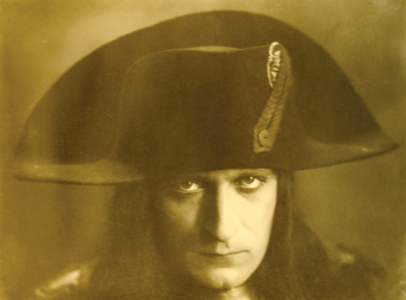The San Francisco Silent Film Festival will present the U.S. premiere of a newly restored version of Abel Gance’s silent epic Napoleon in four special screenings at Oakland’s Paramount Theatre on March 24, 25 and 31 and April 1.

San Francisco Silent Film Festival
By Paul Duclos
Published: March, 2012
The San Francisco Silent Film Festival will present the U.S. premiere of a newly restored version of Abel Gance’s silent epic Napoleon in four special screenings at Oakland’s Paramount Theatre on March 24, 25 and 31 and April 1.
The film was completely restored by Academy Award-winning historian, documentarian and archivist Kevin Brownlow, and the screenings also mark the U.S. premiere of the orchestral score by composer Carl Davis, who will conduct the Oakland East Bay Symphony. This is the first time in nearly 30 years that Napoleon in any form has been screened in America with full orchestra. The Carl Davis score may be the longest continuous film music ever composed and conducted.
The SFSFF’s spectacular presentation at the 3,000-seat, Art Deco Oakland Paramount will be climaxed by film’s original "Polyvision" finale, with the screen dramatically expanding to triple its width to offer both panoramic views and multiple images. (Exactly 25 years after Napoleon’s release, the American process Cinerama would employ a very similar system, but without Gance’s virtuosic use of the three screens.) To re-create Polyvision for the four Napoleon screenings, the Paramount is being fitted with three projection booths equipped with three perfectly-synchronized projectors, all specially installed for by a three-man team from technical specialists Boston Light & Sound.
The restoration, produced by Brownlow with his Photoplay Productions partner Patrick Stanbury in association with the BFI, is the most complete version of Gance’s masterpiece since its 1927 premiere at the Paris Opera. Because of the enormous expense and technical challenges of properly presenting the epic film, it has taken Brownlow and company three decades to mount American screenings with the magnificent Davis score, which has been performed only in Europe and not since 2004.There are no plans to repeat this event in any other city, nor to release the restored version on DVD, BluRay, or television.
Napoleon has not been shown in the U.S. with full orchestra and its Polyvision finale since the early 1980s, when Francis Ford Coppola sponsored a triumphant road show of a shorter version, with a score by his father Carmine. That version ran just under 4 hours; Brownlow’s longer reconstruction runs 5 1/2 hours.
Tickets are now available online through the SFSFF website, www.silentfilm.org.
While Napoleon was the dominant military land power on the European continent, it was the British who controlled the seas.
A handsome new book written by Geoff Quilley argues that maritime culture is critical to our understanding of 18th and 19th century Britain and rethinks the place of visual culture in the relationship between nation and empire.
Empire to Nation offers a new consideration of the image of the sea in British visual culture during a critical period for both the rise of the visual arts in Britain and the expansion of the nation’s imperial power. It argues that maritime imagery was central to cultivating a sense of nationhood in relation to rapidly expanding geographical knowledge and burgeoning imperial ambition. At the same time, the growth of the maritime empire presented new opportunities for artistic enterprise.
Taking as its starting point the year 1768, which marks the founding of the Royal Academy and the launch of Captain Cook’s first circumnavigation, it asserts that this was not just an interesting coincidence but symptomatic of the relationship between art and empire. This relationship was officially sanctioned in the establishment of the Naval Gallery at Greenwich Hospital and the installation there of J. M. W. Turner’s great Battle of Trafalgar in1829, the year that closes this study. Between these two poles, the book traces a changing historical discourse that informed visual representation of maritime subjects. http://yalepress.yale.edu/yupbooks/home.asp
For more on San Francisco cultural topics, visit Paul Duclos’ blog at www.paulduclosonsanfranciscoculture.blogspot.com

